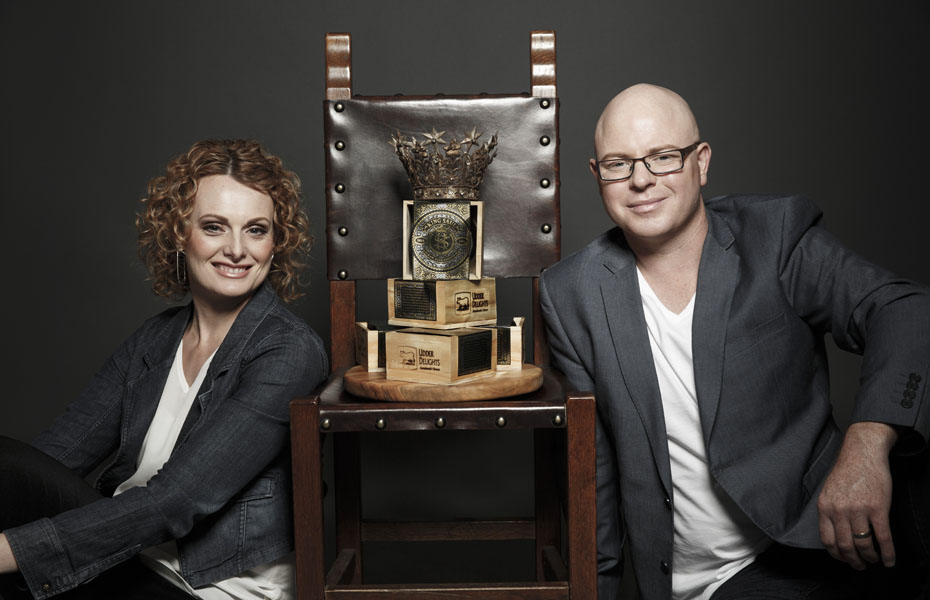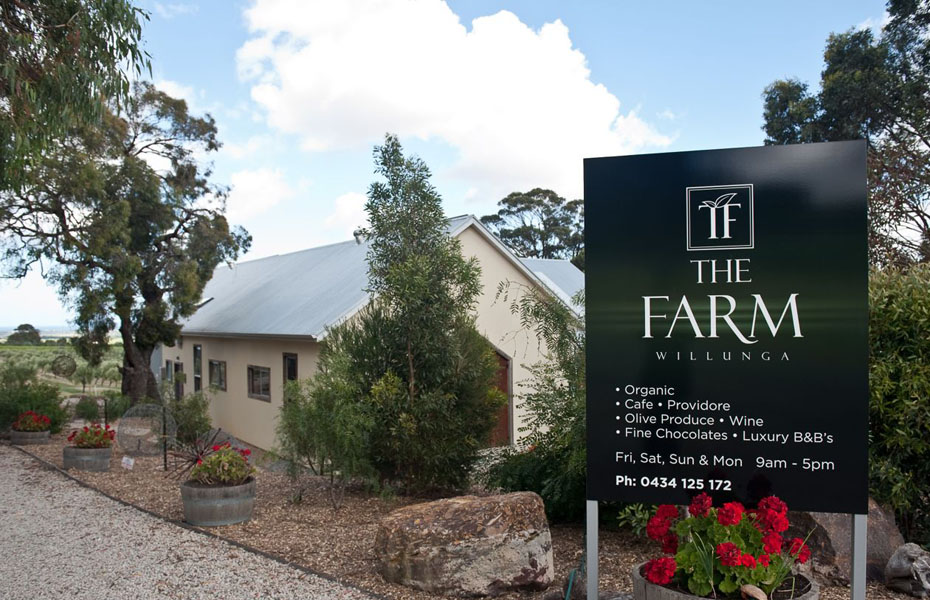The Forager: Raw milk cheese, cherry time


Udder Delights' master cheese-maker Saul Sullivan with King Saul, Australia's first raw milk blue cheese. Photo: Randy Larcombe
The Forager: Australia’s first raw milk blue cheese; your guide to sourcing fresh cherries in the Adelaide Hills; apple cider that drinks like wine; and a wine made from two varieties of Pinot grapes.
Cheese terro(i)r!
In the process of making Australia’s most expensive ($300/kg) and first living raw-cow-milk blue cheese – Udder Delights King Saul Raw Blue – master cheesemaker Saul Sullivan says he has isolated the bacteria that makes his cheese taste so good.
Sullivan says what makes King Saul special is the non-pathogenic Hafnia Alvei bacteria found in the raw milk in the Mt Torrens area that he uses to make the cheese.
“The difference between our Heysen Blue and King Saul is that while Heysen Blue is a batch pasteurised cheese and retains a lot of the goodness of the milk compared to commercial cheeses made with industrial pasteurisers, the King Saul is made with raw milk that has not been pasteurised at all,” he explains.
Pasteurisation is the heat treatment of milk to eliminate most bacteria and lower pathogenic microbial numbers for food safety and preservation.
“It is generally illegal to make or sell unpasteurised blue cheese in Australia, but there are exceptions to those rules,” Sullivan says. “Everyone said we couldn’t do it, that we couldn’t make it to the standards (set by regulatory bodies Food Standards Australia New Zealand and the Dairy Association of South Australia), but I have had a lot of experience in making blue cheese and food safety and I wanted to prove it could be done.

Udder Delights owners Sheree and Saul Sullivan with some of the first wheels of King Saul Raw Blue. Photo: Randy Larcombe
“We invested a lot of time and money without knowing the outcome, but I came up with a plan, all the tests came back perfect and we were given the green light to start developing.
“In the process of trialling and testing, I managed to isolate the Hafnia Alvei bacteria in the raw milk we are using. It is the same bacteria that can be located in the terroir of the famous food and wine-producing regions in France.
“It is a microbe that acts like a sponge, drawing in all the flavour and concentration of the area in which it lives. It is a non-pathogenic microbe, a bacteria that is definitely not dangerous.
“King Saul is made from selected milk from a farm where we control what the cows eat and drink, introducing native flowers and flora into their diets and spring water from the river. By taking the freshest milk from those cows and by not pasteurising the milk at all, we are able to make sure that a high count of live Hafnia Alvei is present, so all the flavours of the terroir – from the soil, to the water, to the natural plants – are concentrated in the flavour of the milk.
“Hafnia Alvei doesn’t exist everywhere – it survives in areas where there is a lack of pollution.
“I believe Hafnia Alvei is a concentrator of flavour. It makes the grass taste better to the cow, but it’s heat sensitive and the pasteurising process kills it off. By using unpasteurised milk, the bacteria stays alive and as a result we’re getting these super-concentrated flavours in the cheese.
“The bacteria remain alive in the cheese and continue to release the concentration of flavour through the ageing process. Like red wine, you can eat it now or in a year’s time or in three years’ time; the more you wait, the creamier it gets, as the blue mould breaks down the fats in a process called lipolysis.
“I believe that the first mouthful of King Saul will be like the first mouthful of Grange Hermitage – it’s an emotional experience as well as a flavour sensation. You are eating a time capsule, a piece of history from that terroir.”
“King Saul will form the helm of our new Royal range of super-premium raw milk cheese. We’re looking at starting with raw milk, cloth-matured cheddar.”
More information can be found here.
In other cheese news…
Kris Lloyd’s Artisan Range Persian Fetta Cow/Goat won a super gold medal at the World Cheese Awards in London this month.
Lloyd was the only cheese-maker from South Australia to enter the awards, which attracted 3000 cheeses from all over the world. She was also the only South Australian to be asked to judge at the event.
Her blended and marinated fetta was given a gold medal, then after reassessment of the gold medal entries, the cheese was awarded a super gold.
“My cheese unfortunately didn’t make the shortlist for the World Champion entries, but afterwards one of the judges approached me and said that I had taken fetta cheese to a new level.”
Pick your own cherries
The cherry season generally starts in November and continues until mid-January, depending on the variety, location and season. During this time, many South Australian cherry producers offer pick-your-own opportunities, shed-door sales and value-added produce.
Cherries SA, the Cherry Growers’ Association of South Australia, releases an annual Cherry Map with information about the orchards and shed-door outlets offering consumers the chance to visit.
The ninth produced, the 2014-2015 Cherry Map is a region-by-region guide to the growers, their specific location and contact details, the varieties grown, and other fresh and value-added produce available.
“South Australia will produce 2500 tonnes of cherries this year with an estimated crop value between $15 and $20 million,” says Cherries SA president Andrew Flavell .
“With around 100 cherry growers in South Australia, I am very pleased to say that so many growers are opening their doors to the public.
“The cherry-growing districts are so close to the city that this is a great opportunity to talk to the growers and learn more about the different varieties, to pick their cherries or simply taste and buy pre-packed fruit.
“Each orchard has something quite different and the season is long enough to try more than one.”
Flavell says to expect a price variation in the fruit offered by orchards on the Cherry Map.
“Fruit prices vary depending on the quality and size of available fruit, and whether it’s an orchard providing a ‘pick your own’ experience or selling pre-packed fruit.”
The Cherries SA website also offers a range of recipes and nutritional information about cherries and the different varieties available. In December the website will also offer a downloadable Cherry Map app.
The 2014-2015 Cherry Map can be downloaded here.
Like a Riesling
If you find apple cider too sweet and too short on the palate, Adelaide Hills winery Sidewood is making a version that may be more likely to please.
Winner of the 2014 Royal Adelaide Cider Competition, Sidewood cider is said to be made in the style of a Riesling.
The drinking experience begins with a nose full of crisp apples, leading to pure apple flavour and upfront sweetness complemented by tight acidity and soft carbonation, and finishing with a dry, cleansed palate.
This handmade premium cider is made from Adelaide Hills apples selected for flavour and acidity, crushed then cool fermented within hours of picking at the Sidewood cidery and winery at Verdun. More information can be found here.
Two Pinots are better than one
Gentle Folk Wines at Basket Range has produced a half Pinot Gris half Pinot Noir wine called Pinot & Pinot that is said to be quite the drop to try.
Winemaker Gareth Belton, who works in seaweed research by day and makes wine in his spare time, has put some Pinot Gris fruit from a Hahndorf vineyard with some Pinot Noir fruit from Uraidla to make the wine. The fruit was picked on the same day and co-fermented on skins for one week.
Gentle Folk makes small quantities and the 33 cases of Pinot & Pinot has already sold out. However, you may be able to try it at Bistro Dom, Clever Little Taylor, Cork Wine Café, East End Cellars, Fall from Grace, Orana, Parade Cellars and Street ADL. More information can be found here.
Openings
The Farm Willunga
Overlooking olive groves and vineyards to the Gulf of St Vincent, The Farm Willunga consists of a licensed café and luxurious bed and breakfast apartments.
The property is a 6ha certified organic and biodynamic working farm which produces its own handmade olive oil soaps and skincare products. Fresh local food and wine is reflected in the café menu and wine list and in the gourmet breakfast hampers.
Owner Robyn Dahl Lewis seeks to share the sustainable farm environment with guests, who can arrive either by car or helicopter, as provision has been made for both modes of transport.
Africola
This new venture by chef Duncan Welgemoed and designer partner James Brown opens tomorrow at 4 East Terrace, Adelaide. Expect contemporary African food exploring native flavours from the Zulu and the Xhosa tribes and influences of the Portuguese, Indians, Malaysians and Dutch who settled in South Africa. It will also serve house-brewed beer and South African and local wines.
Africola will open for dinner (Tuesday to Saturday) and weekend brunch.
Read The Forager’s recent interview with Welgemoed here.
Fino @ Seppeltsfield
Opening this Saturday (November 22) in the renovated 1850s bottling hall at Seppeltsfield, Fino @ Seppeltsfield will offer an a la carte menu featuring Barossan Schu Am Berkshire Pork, Savannah Chickens and Hutton Vale Lamb, an eclectic wine list of Australian wines including all the Seppeltsfield house wines and fortifieds, as well as a bar menu for drinks and snacks.
Fino @ Seppeltsfield will be open for lunch every day and for dinner on Friday, Saturday and Sunday nights.
Events
Sale in the Ballroom – November 23 and 24
Good-quality South Australian wine sale will be for sale at the Kings Head Hotel ballroom this Sunday (November 23) from 2pm to 5pm and Monday from 4pm to 7pm – or until sold out. Non-list stock, odd vintages, odd bins and back vintages from $10 to $30 or wholesale price + 10 per cent. For more information phone 0413 393 580
Dessert Divas book signing – November 25
To coincide with the publication of her new book Dessert Divas, Christine Manfield will sign copies of her book for sale from 6pm at Bottega Rotolo on King William Road. For more information call 8271 8866.
Diner en Blanc – November 29
As the worldwide phenomenon Diner en Blanc celebrates its 26th anniversary this year, it will be Adelaide’s second secret epicurean picnic. Last year’s Diner en Blanc attracted 750 enthusiasts to its all-white BYO event and this year it will again take over an undisclosed public space with more than 1000 people expected to attend. Invitation is by word-of-mouth or by signing up to the waiting list.
Wild Harvest Lunchernoon by Fair Food Adelaide – November 30
Celebrating Fair Food Adelaide and all foods good and local, a gourmet long-table lunch will be prepared by guest chef Kamilah Kadir using high-quality ingredients sourced from organic farms or wild foraged. This slow Sunday afternoon event will be held at the Silvermine House, Glen Osmond. Guests who cycle to the event will be offered a special cyclist price. Address and directions (including a cycling map) will be given once you’ve booked. Tickets are limited and cost from $70 per head, including the three-course feast and wine. More information can be found here.







